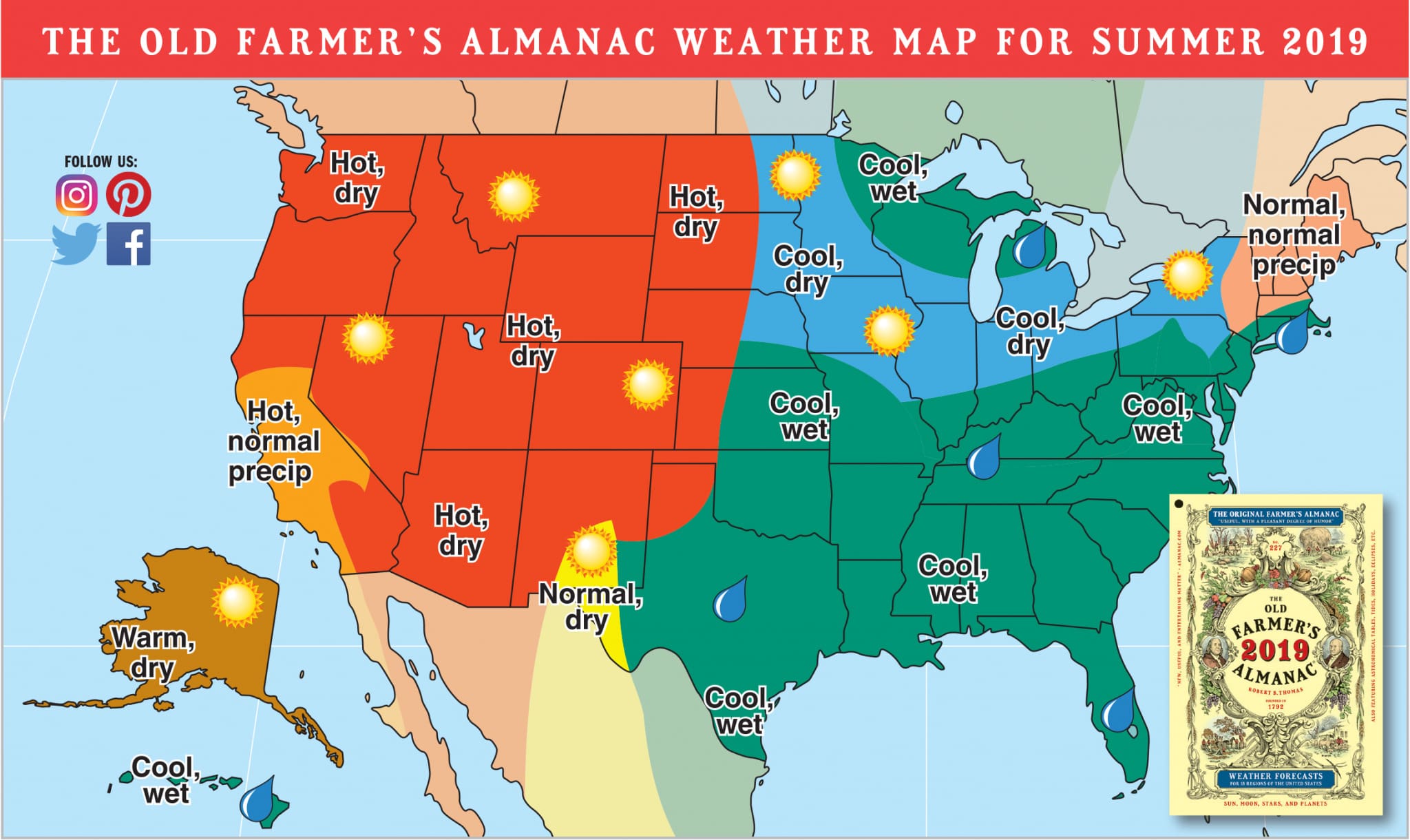
North American summers are hot. Most summers see heat waves in one or more parts of the U.S. As a result, heat is one of the leading weather-related killers in the U.S., contibuting to hundreds of fatalities each year and even more heat-related illnesses. Here’s a look at what’s in store for summer temperatures across the country and how you can help your employees avoid heat-related illnesses.
Heat-related Illnesses: What’s in Store for Summer 2019
The summer solstice (Friday, June 21) marks the official start of summer, which means it’s going to get hot! The Farmer’s Almanac says some parts of the country are expecting a hotter- and drier-than-normal season, while others are in for some relief from last year’s extreme heat.

Hot & Dry Out West. The western half of the country will bear the brunt of the heat, with hotter-than-normal summer temperatures in the forecast. The one exception to this extra heat is an area covering parts of western Texas and New Mexico, where summer temps will be on par with normal. Expect the worst of the hot weather to coincide with the height of summer in mid- to late July, with additional warm spells in mid-June and late August. Alongside this heat, the West will see drier-than-normal conditions.
Rain in the South. The southern U.S. will see higher amounts of rainfall and slightly cooler temperatures. The hottest weather will be in late May and August in the Southeast region, and in mid-June and mid-July elsewhere. The rainiest part of summer for the South will stretch from mid-July through August, with threats of hurricanes and tropical storms wrapping up the season in August and September.
Mixed in Midwest & Northeast. As in the South, a good portion of the North will experience slightly cooler temperatures and more rainfall this summer. The Northeast is in for a fairly standard season, with normal temperatures and rainfall amounts.
Heat-related Illnesses: How to Protect Yourself
Landscape industry experts recommend the following safety tips to protect yourself against heat-related illnesses and skin cancer.
- Give your body time to acclimatize to hot environments. It takes your body weeks to build up tolerance for working in warm temperatures. You should gradually move toward a full workload when new to such work and after being away from the job a week or more.
- Know whether you have a condition or are taking medication that increases your susceptibility to heat-related illnesses. Be especially careful if you have hypertension, high cholesterol or diabetes; are obese; or take anti-inflammatory medication as this increases your susceptibility to heat-related illness,
- Tell your employer about medical conditions you have and medications you are taking.
- When working in hot environments, drink water every 15 minutes. Do this even if you are not thirsty.
- Take frequent breaks in shade or air conditioning, if possible.
- Move to shady areas during breaks. The temperature can feel up to 15 degrees cooler.
- Dress for warm weather. Wear lightweight, long-sleeved shirts, pants, and a loose hat with at least a 4-inch brim and a drape to cover the back of your neck. This will keep you cooler and help protect your skin from sun exposure.
- Apply sunscreen. Skin cancer is the most common form of cancer, and sun exposure causes more than 90 percent of skin-cancer cases, according to the Skin Cancer Foundation. To help prevent skin cancer, apply sunscreen with an SPF of at least 30 every day you work outdoors. You should apply 1 oz. of sunscreen, which is about a shot glass full. Most people apply only a quarter to half the required amount.
- Reapply sunscreen every 2 hours. Also reapply after sweating a great deal or toweling off. Since lightweight clothing doesn’t provide full sun protection, consider wearing clothing with embedded sunscreens or using laundry detergent that increases your clothing’s ultraviolet protection factor (UPF).
- Know the symptoms of heat-related illnesses:
- Dehydration – decreased perspiration; thirst; a cool, clammy feeling; headache; poor appetite; dark-colored urine
- Heat exhaustion – dizziness, headache, sweaty skin, weakness, cramps, nausea, vomiting, rapid heart beat
- Heat stroke (a literal stroke that can be fatal) – red/dry skin, high temperature, confusion, convulsions, fainting
- Monitor yourself as well as fellow workers for signs of heat-related illnesses. Remind co-workers to replenish fluids.
- Tell a co-worker or supervisor if you experience symptoms of heat-related illness. Go to a cool, shaded area and rehydrate with water or sports beverages if you are dehydrated. You can return to work when you feel better. If symptoms are still present after 30 minutes, seek medical attention.
- If a co-worker displays signs of heat exhaustion, call 911 and guide that person to a cool, shaded area. Take off the person’s hat, shoes and socks and provide a sports beverage while waiting for medical attention.
- Know how to handle heat stroke. If a person displays signs of heat stroke, take the steps noted above for heat exhaustion and spray or wipe the person’s skin with cool water and fan the person. If a seizure occurs, turn the person onto the side, tilt the head back and thrust the jaw forward in order to keep the airway open.
- Examine your body regularly and schedule an appointment with a doctor if you notice spots on your skin that change size, shape or color. Skin cancers often appear as:
- Pale, pearly, wax-like nodules;
- Red, scaly, sharply outlined patches;
- Sores that don’t heal; or
- Small, mole-like growths (melanoma, the most serious form of the disease).
In addition to these resources, OSHA offers a free OSHA Heat Safety App for both Android and iPhone.

